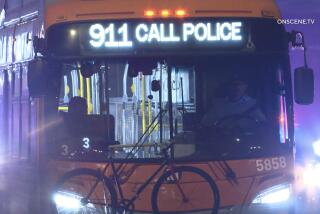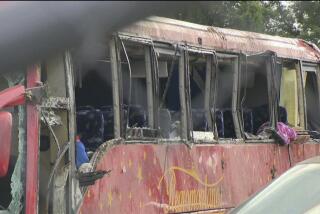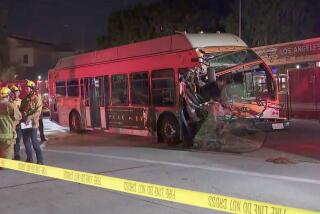Girl Scouts’ Bus Had History of Brake Problems, Company Says : Tragedy: But officials say the troubles were minor and taken care of. CHP revises its figures and says safety citations against the firm were fewer than reported.
PALM SPRINGS — The chartered yellow bus that skidded off a mountain road north of here, killing seven Girl Scouts and supervisors on a summer tour of California, had a history of brake problems, officials said Friday.
The president of the Kansas-based company that operated Bus No. 369 confirmed that maintenance records showed a series of driver requests for brake repairs. He called the problems “minor” and said mechanics promptly fixed them once they were brought to their attention.
“I have reviewed the reports for the past 15 months and they indicate requests for attention to the brake system by our drivers,” said Michael Smith, president and chief executive officer of Mayflower Contract Services. “On every occasion, our mechanics gave them attention within 24 hours. . . . They were minor adjustments.”
In Sacramento, California Highway Patrol spokesman Sam Haynes sharply scaled back the number of citations issued to Mayflower buses, saying the files the CHP initially released after the accident lumped together the records of Mayflower’s school and tour buses with the company’s trucks.
Mayflower buses received only seven CHP citations in the 12 months preceding the crash, not 559 as reported earlier. Of those, two were for faulty brakes. Previously, CHP files indicated that the company had received 220 citations in the last 12 months for faulty brakes.
At the same time, Sgt. Ron Starrs of the Palm Springs Police Department said investigators from his department, the CHP and National Transportation Safety Board have not begun to inspect the bus maintenance records. Investigators have been at the scene since the accident and will spend the weekend poring over the wreckage now in a city yard. Starr said the records will not be reviewed until at least Monday.
Meanwhile, the first Girl Scout to discuss the crash publicly was released from a Palm Springs hospital Friday. She gave a gripping account of the terror that unfolded on the eastern slope of the San Jacinto Mountains on Wednesday afternoon.
Wearing a bandage on her left elbow and speaking in a calm but weary voice, Sapreet Saluja of West Windsor, N.J., said the bus appeared to be descending the steep grade normally when it began to pick up speed.
“Some of the girls yelled, ‘What are you trying to do, kill us?’ ” recalled Sapreet, 15, who clutched a heart-shaped balloon as she talked to reporters from a wheelchair just before being discharged from Desert Hospital. At first, she said, “We thought it was a joke or something.”
Within seconds, the girls knew better.
As screams filled the air, the bus careened wildly around two sharp corners and headed for a cliff.
“We were flying along,” she said. “It felt like a roller coaster. . . . One of the leaders said: ‘Brace yourself! We don’t have any brakes!’ . . . I held on to the girl next to me. . . . We all just held on.”
Torn from her friend’s embrace, Sapreet wound up beneath a heap of mangled wreckage, conscious but confused.
“I was under the pile for about 10 minutes before I got out,” she said. “I wiggled and wiggled and finally made it.”
In the chaos of the aftermath, Sapreet said, she found another injured Scout and comforted her until paramedics arrived. Initially, Sapreet had no trouble walking around the rugged gully where the bus came to rest, its flattened nose atop a giant boulder.
“But then, I guess, I went into shock,” she said. “I couldn’t walk anymore.”
Brought to the hospital, doctors found that she had suffered some scrapes and bruises, but was otherwise unhurt. Mayflower’s president apologized to the victims Friday and defended his company’s safety record.
“I want to extend to all of those affected by this accident our deepest regrets,” said Smith, whose company has offered to contribute to a Girl Scout fund for victims. “It is beyond words for me to describe our feelings.”
Smith said California “enjoys the most sophisticated and rigorous (bus) inspection program” in the country. He said Mayflower’s own program is a “complement” to that.
The company requires “monthly, weekly and daily inspections” of its fleet, he said. In addition to the 30 hours of pre-employment training, Mayflower drivers must complete ongoing refresher courses as well as special training if they are involved in an accident, he said.
Bus No. 369 had completed a trouble-free mountain trip in San Diego County the day before the accident, Smith said. At the end of that journey, to Palomar Mountain, the driver inspected the bus and filled out a trip log, as required by Mayflower.
“He reported all systems were operating properly, including the brakes,” Smith said.
Investigators from state, local and federal agencies should be able to determine whether that was the case, said Kevin Conboy, a member of the CHP’s investigation team.
Investigators also will be able to inspect the brakes’ drums and shoes for scarring, heat marks or other evidence that the driver, Richard A. Gonzales, 23, may have misused the brakes in the seconds before the crash. Gonzales was among those who died.
While investigators have not determined how much experience Gonzales had driving the type of bus that crashed, Mayflower officials have said he had “some experience driving smaller buses, most (of it) on city streets,” safety board member John Lauber said.
Lauber said that the type of automatic transmission in Bus No. 369 functions in a way that could, under certain circumstances, have contributed to the accident.
Drivers of heavy vehicles such as the bus normally use lower gears to slow the vehicle on downgrades and take a lot of the strain off the brakes. Lauber said that even if manually shifted into a lower gear, the transmission in the bus that crashed would shift automatically into a higher gear when it reached a certain speed.
While the speed of the bus has yet to be determined, witnesses said it accelerated considerably before it skidded off the road.
At Desert Hospital, two patients were reported in critical condition, six in serious condition and eight in fair condition. The other twelve were at John Fitzgerald Kennedy Memorial Hospital in Indio and Eisenhower Medical Center in Rancho Mirage.
Among the relatives waiting anxiously for medical updates at Desert Hospital were Teri and Frank Andreozzi of Havertown, Pa. Their 16-year-old daughter, Alexis, listed in fair condition, suffered a head injury and seemed to look worse Friday than she had the day before, the couple said.
“Her eye’s all swollen up . . . and she has a big cut from her forehead across her scalp to the base of her skull,” Frank Andreozzi said, wringing his hands as he sat in the hospital lobby.
“It’s hard to deal with, but we’re one of the lucky ones,” Teri Andreozzi said. “Alexis was sitting right next to some of the girls who didn’t make it.
“That makes you realize how close it was.”
Times staff writers Mark A. Stein and Eric Malnic in Los Angeles contributed to this story.
More to Read
Sign up for Essential California
The most important California stories and recommendations in your inbox every morning.
You may occasionally receive promotional content from the Los Angeles Times.









